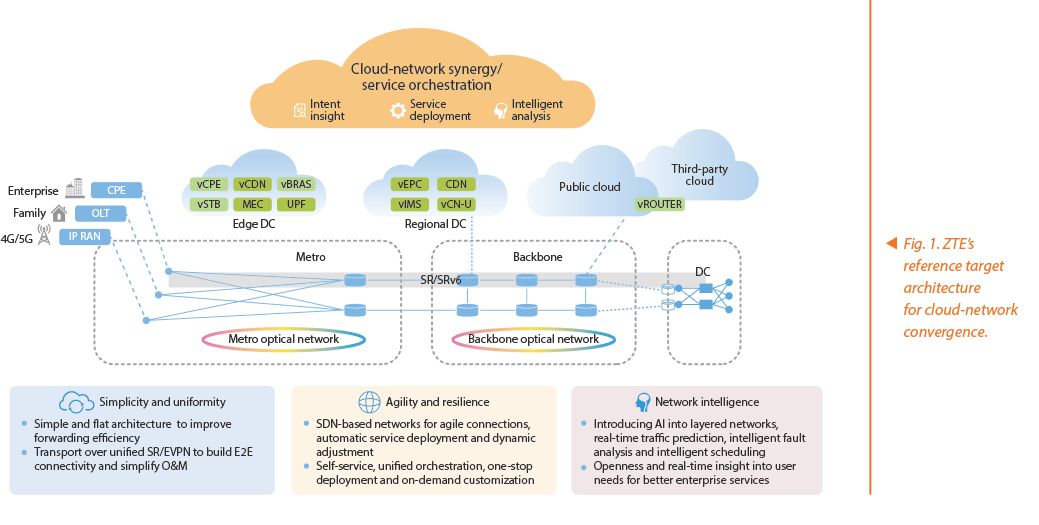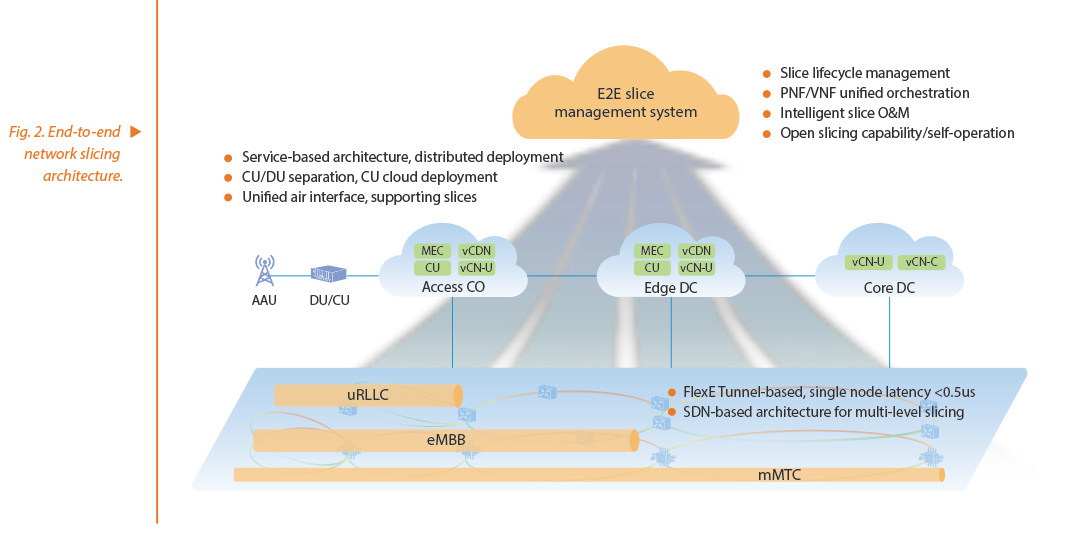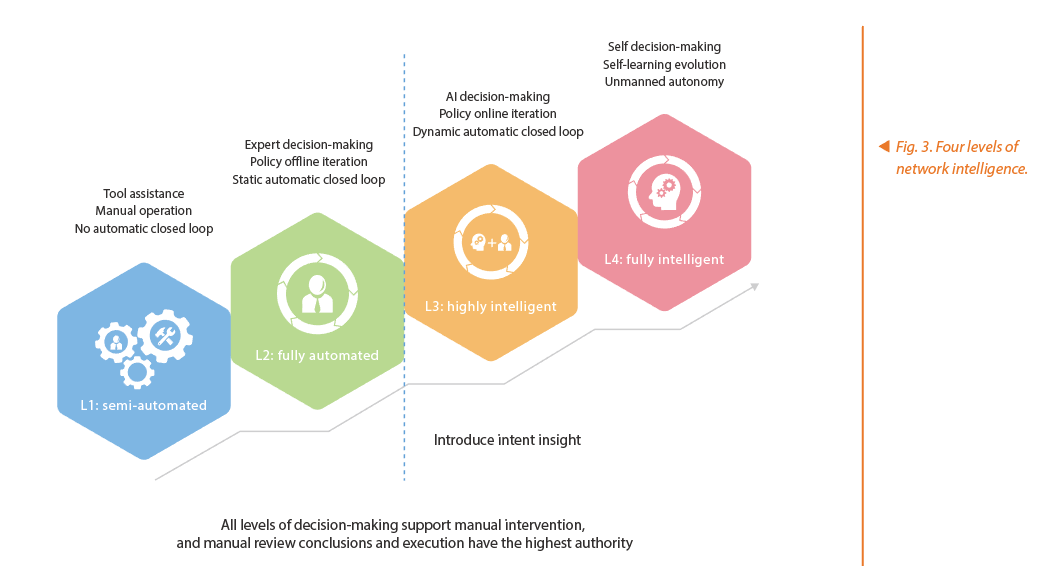Future Network Architecture Based on Cloud-Network Convergence
Major global operators have started their infrastructure network transformation programs centered on cloud services, such as AT&T's Domain2.0, Deutsche Telekom's PAN-EU, China Telecom's CTNet2025, China Unicom's CUBE-Net, and China Mobile's NovoNet. However, their existing networks are vertical chimney-type private networks that are separated from the cloud and unable to meet the agility, flexibility, programmability and openness required for cloud service development. Changing the existing network architecture is a hot topic in the industry.
Network architecture design belongs to the top-level design of the network. It is not only a series of high-level abstract design criteria, evolution goals and technical frameworks, but also the basis of technical decisions. The network architecture is not only a purely network-level technology strategy, but is based on network re-architecture that will drive a series of deep transformations involving organizational structure, production process, management model, and talent reconstruction. ZTE has launched its target architecture for deep cloud-network convergence that can cover full-scenario services, focus on user experience, and connect all things with the cloud to help operators grasp the opportunities of digital transformation.
Basic Principles
Facing the needs for cloud-network convergence, ZTE has proposed to build a future cloud-network converged network based on the following principles.
—Simple architecture with the separation of infrastructure and services: Services are decoupled from infrastructure. The service layer is flexible, open, and programmable, while the infrastructure layer focuses on large capacity as well as SLA and QoS guarantee.
—Flexible expansion: Learning from the idea of Spine-Leaf data center rchitecture, service network elements are based on the cloud or pool. Networks are expanded on "stacking" modules rather than upgraded on the original modules (network elements).
—Experience driven, automatic and intelligent O&M: The deep SDN management, control and orchestration of cloud-network convergence enables active care and predictive network adjustment. Through network programmability and automation, an autonomous network can be realized.
Reference Target Architecture
Based on the above-mentioned principles for cloud-network convergence, ZTE has proposed a reference target architecture (Fig. 1).

Decoupling between the two layers allows for independent planning. The flexible, agile and rapid deployment on the service layer is achieved through decoupling, and any change to the deployment has no impact on the underlay layer. The underlay layer focuses on fast connection, automatic establishment, and SLA guarantee.
By introducing new technologies and flexibly using SR/EVPN/VxLAN, the underlay layer greatly simplifies network protocols, reduces O&M difficulty, makes more flexible access to the cloud, and enables on-demand network changes. The IP and optical synergy improves transport efficiency and simplies O&M. By decoupling from the resources, IP connectivity only focuses on reachability rather than service attributes, so the IP technology is greatly simplified. Optical networks are no longer just pipes, but has intelligent features that can be dynamically configured. The IP and optical resource pool dynamically matches service requirements, greatly improving resource utilization and reducing transport network costs.
To achieve agility and resilience, the target architecture also needs to support end-to-end network and service slicing as well as hierarchical network slicing solutions with hard isolation and soft isolation capabilities. For some services that have general security requirements, the architecture provides soft slicing based on L2 or L3 logical isolation. Through the packet multiplexing, bandwidth utilization can be maximized. For financial and enterprise private line services that require exclusive resources, low latency and high reliability, hard slicing based on FlexE can guarantee the exclusiveness and isolation of network resources.
The end-to-end network slicing architecture supports E2E slice lifecycle management ranging from terminal to core network (Fig. 2).

—Wireless slicing: For shared wireless slice, a user session can select the configuration parameter package according to the slice ID to provide different air interface features. For exclusive wireless slices, physically isolated slices can be provided through the division of different frequency bands.
—Transport slicing: SDN-based 5G transport network can be virtualized into multiple virtual networks to differentiate forwarding performance needs. According to the scenario QoS and latency needs, a service-oriented connection tunnel can be established on the corresponding virtual network to form a bearer network (BN) slice.
—Core network slicing: 5GC network functions are deployed on demand on the multi-layered DC to form CN slices. The user plane UPF can be flexibly moved down and deployed to meet to the latency requirement in the scenario, and the control plane NFs can be shared between different slices.
Introduction of Network Intelligence
The target architecture for cloud-network convergence needs to be built on network intelligence. ZTE has proposed four levels of network intelligence (Fig. 3).

—Intelligent active data collection: Telemetry collection + AI
—Thick orchestrator supports service innovation: service model + atomic network capability abstraction
—Standard northbound interface of the controller: hierarchical decoupling + simplified architecture
—Hierarchical big data AI analysis: operational intelligence + network intelligence
—Strategic hierarchical closed loop automation: hierarchical closed loop + unified policy
Unified orchestration is the basis for rapid deployment of cloud-network services. The unified orchestration allows for one-click cloud-network service activation, E2E overlay network setup, and E2E service guarantee. The network is based on SDN, controllers are deployed based on different domains and can coordinate with each other for flexible connection, and edge nodes can be flexibly loaded with traffic. In this way, networks can be set up on demand, and unified management can be implemented for the underlay network. To achieve unified orchestration of cloud-network services, it is necessary to strengthen the orchestration management and enhance service innovation. Building the orchestrator for cloud-network convergence involves:
—Atomic network capability for on-demand cascade connectivity
—Component-based service functions for customized APP development
—Compatibility with controller/EMS for combined new and old network configuration
—API-based northbound interface for internet operations
ZTE actively introduces AI into the telecom field. With its uSmartNet solutions, ZTE can provide complete data awareness, intent insight, and intelligent analysis for telecom networks, helping operators adapt to trends, meet challenges and build an AI network capable of autonomous management, future foresight, on-demand change, and smart operation.
[Keywords] Cloud-network convergence, Reference target architecture, AI, network intelligence